What is the Nebraska Instructional Materials Collaborative?
The Nebraska Instructional Materials Collaborative, or NIMC, highlights high-quality, standards-aligned instructional materials and offers Nebraska-specific guidance documents to ensure materials meet the expectations of Nebraska’s Content Area Standards. Through the NIMC, the NDE and key partners are committed to providing statewide leadership that informs and supports the decisions made locally related to curriculum and instructional materials.
Quick Links:
Purpose
Every Nebraska student deserves the opportunity to learn from high-quality, standards-aligned instructional materials to prepare for success in college, career, and civic life. Through the Nebraska Instructional Materials Collaborative, the Nebraska Department of Education and key partners, we are committed to providing statewide leadership that informs and supports the decisions made locally related to curriculum and instructional materials.
The graphic above shows the interactions of standards, high-quality instructional materials, local curriculum, and assessments in service of teaching and learning. Please visit Content Area Standards – Nebraska Department of Education to access Nebraska’s College and Career Ready Standards for all subject areas.
Definitions
A curriculum is determined locally and reflects “how” teachers help students learn the content within content area standards. A curriculum outlines the intended outcomes, content, experiences, assessments, and resources for measuring student learning, and it also includes the scope and sequence of what is taught in grades K-12.
Instructional materials are the tools and resources that are used as part of a locally-determined curriculum.
Assessments are the multiple measures (formative, interim, and summative) used to gather evidence of student learning relative to content area standards.
During classroom instruction, a teacher implements the locally-determined curriculum, including instructional materials, and uses evidence-based teaching methods and strategies to engage students to support student learning of content area standards.
Grade Appropriate Assignments
The quality of materials we put in front of students makes a difference in what and how much they learn. Research is clear that a shift from weak, unaligned materials to strongly-aligned ones has a big impact on student achievement. In fact, better quality materials yield significant improvements that are equal to or greater than other kinds of intervention. And the cumulative positive effect on learning is even stronger when year over year, students consistently engage with rigorous texts, tasks, and assignments at or above their grade level.
Strong Instruction
Excellent instructional materials can transform teacher practice. Quality materials provide a rich and coherent sequence of content within and across grade levels, freeing up teachers’ valuable time and resources so they can prioritize instruction instead of seeking out or creating their own materials. HQIMs help all teachers, especially novices, deepen their subject knowledge and knowledge of the standards, and skillfully and consistently use research-based strategies and scaffolds.
Deep Engagement
When instruction and materials are engaging, students are more likely to be engaged. And the quality of materials plays an important role in making sure they are. Excellent materials are ones worthy of students’ time and attention. They’re full of meaningful, relevant, and rigorous content, and attend to the linguistic and cultural needs of students. Quality, standards-aligned materials are designed to actively engage students with ample tools and strategies for exploration, collaboration, problem-solving, and grade-level learning experiences.
Teachers Who Hold High Expectations
The relationship between teacher mindset and student achievement is clear. Teachers who hold high expectations for their students provide them stronger assignments and stronger instruction. Their practice is driven by the belief that all students can meet grade-level standards. Quality instructional materials give teachers the tools to ensure students have consistent access to grade-level texts, tasks, and assignments. Students benefit even more when the instruction they receive is within a positive, system-wide culture that holds their learning in high regard.
The Council for Chief State School Officers Instructional Materials and Professional Development (IMPD) Network
In 2017, Nebraska became one of the first eight states to join the Council for Chief State School Officers’ (CCSSO) Instructional Materials and Professional Development (IMPD) Network. The IMPD Network is dedicated to ensuring that every student, every day, is engaged in meaningful, affirming, grade-level instruction. The Nebraska Department of Education launched the Nebraska Instructional Materials Collaborative in 2018 and since then, has seen tremendous statewide growth in the adoption and implementation of high-quality materials. Since 2019, the selection of HQIM for K-5 ELA classrooms in Nebraska districts has grown from 7% to 80%. The usage of strongly aligned mathematics materials continues to increase, with the percentage of Nebraska teachers reporting weekly use from 20% in 2019 to 61% in 2025. Likewise, the consistent usage of strongly-aligned ELA materials has increased from 5% to 58%. Data from the 2024 RAND American Instructional Resources Survey shows that teachers in IMPD Network states are using aligned curricula at higher rates than the national average.
Today, 15 states are supported by the IMPD Network, and their efforts have translated to increased access to high-quality instructional materials and professional learning for educators. To learn more about the impact of the IMPD Network, please see CCSSO’s High-Quality Instructional Materials Network and the 2024 IMPD Impact Report.
2017 IMPD Network States
Nebraska
New Mexico
Mississippi
Tennessee
Delaware
Massachusetts
2020 IMPD Network States
Texas
Arkansas
Louisiana
Kentucky
Ohio
2022 IMPD Network States
Virginia
Maryland
2024 IMPD Network States
Oregon
2025 IMPD Network States
New York
For more detailed information, visit our FAQ page



